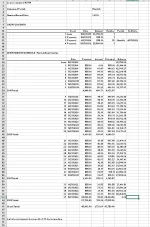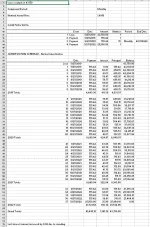Just trying to make sure you aren’t spreading fake news about how you are only borrowing $18,250.
I, as others, should just ignore you but you really need to take a step back and look at what we are talking about. As shown a few times, the first three years of the lease you are reducing the price of the vehicle by 18,250. Call that amount "borrowing", "Depreciation", "Nellie's magic number", it really does not matter. What matters is that is the amount that the total price (43,750) of the vehicle is being reduced for the three years of the lease. In order to get the total price reduced by 18,250, it costs you 1,745. That is generally called "rent charge", but some call it "interest" and I guess it could also be "Nellie's nemesis". The term doesn't matter, what is important is that is the amount it will cost you to reduced the price by 18,250.
At the end of the lease you would have to either pay cash or finance the residual value. If you were financing, then the loan for the 25,500 would start with a new amortization table that has nothing to do with the lease.
As noted a few times amortization tables have absolutely nothing to do with this discussion since we are not comparing a lease to a loan. What we are doing is looking at the effective interest rate on the depreciation amount. But since you seem to love them so much maybe you can use them to help you understand. As you said, the interest portion of a loan payment is higher at the beginning of the loan and goes down over the life of the loan.
While this is not meant to be a representation of the lease discussion it may turn on the light for you. Run an amortization table for a loan of 43,750, at 1.6% for 5 years. With some rounding your payments should be 759 a month which of course represents a payment to principal as well as interest. You go along happily paying and about two years from now after you have paid approximately 18,500 in principal that "Help a CPA" grant comes through and you are able to pay off the remaining balance.
Sitting around admiring the huge pink rubber eraser that signifies your award, you decide to calculate what your interest rate was on the 18,500 that you borrowed for the two years. You fire up the old Commodore 64 and look at the amortization table for the loan and you see that you paid a total of about 1,200 dollars in interest during the two years you had the loan. Now the quest for that mystical number has your heart pumping as you recap the numbers. You ended up borrowing $18,500 for 2 years and paid 1,200 in interest, the loan was at 1.6% but what what effective interest rate did you really pay. A smile comes on your face as you open Lotus 1-2-3, knowing the amortization table will give you the insight. You plug in a few numbers and there it is, shining as if a halo is around cell A4. In order to pay $1,200 on a loan of 18,500 for two years the interest rate would have to be 6.11%. Astonished since your loan was for 1.6%, you sit back in your easy chair, ruffle the whiskers on your chin and mutter to yourself - "So that is what TurtleBoy has been trying to teach me about effective interest rates".

This time I mean it, we are beating a dead horse. Feel free to take a last comment should you feel the need.











